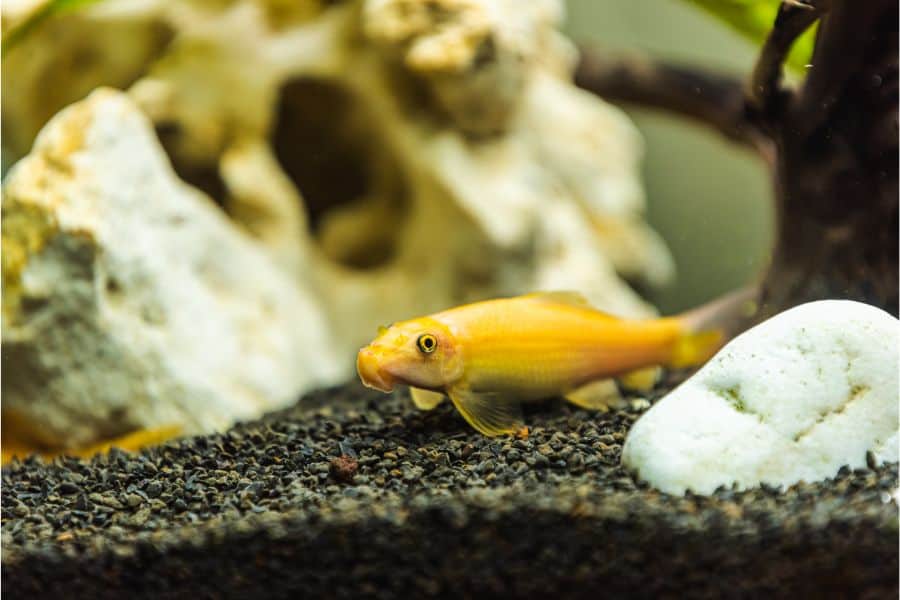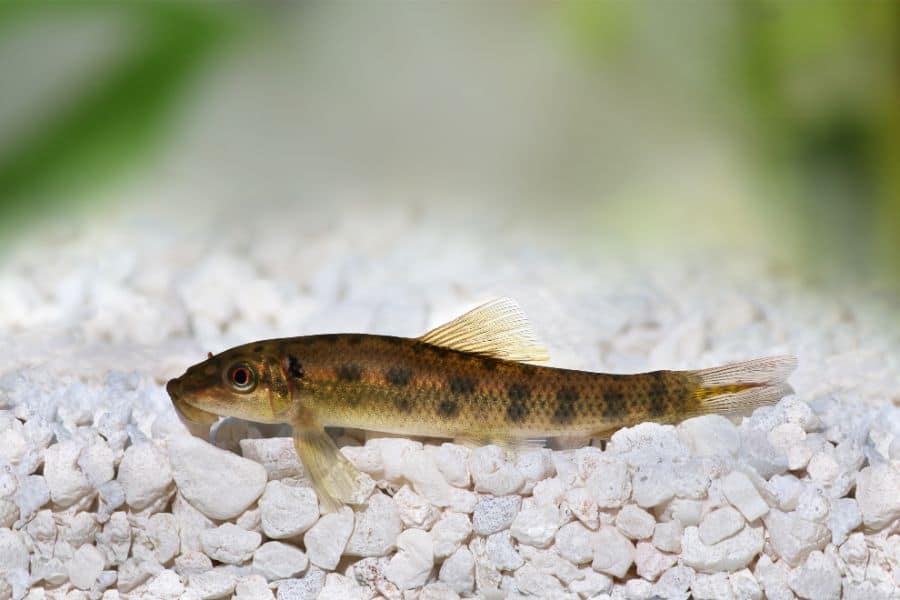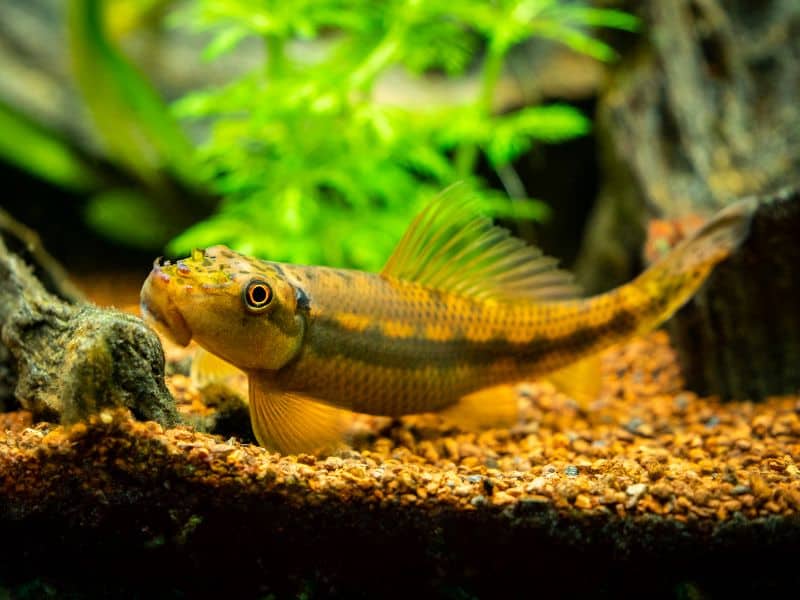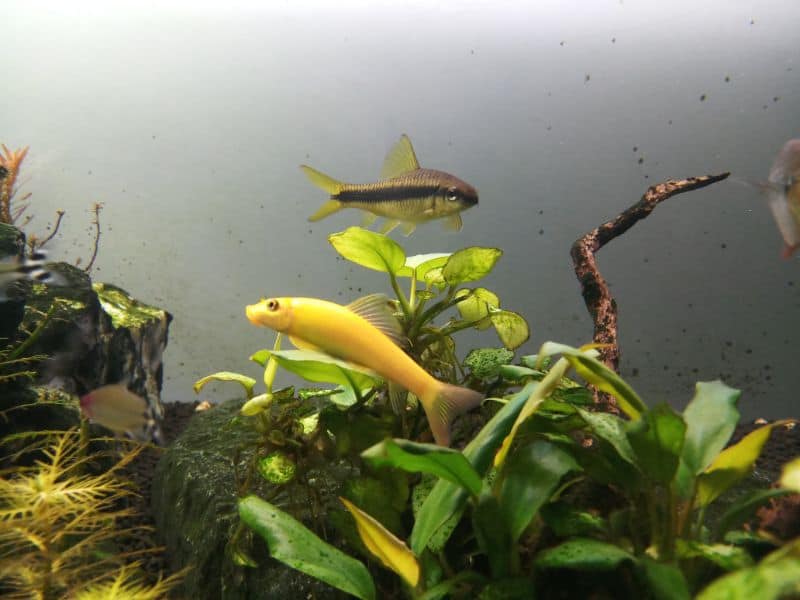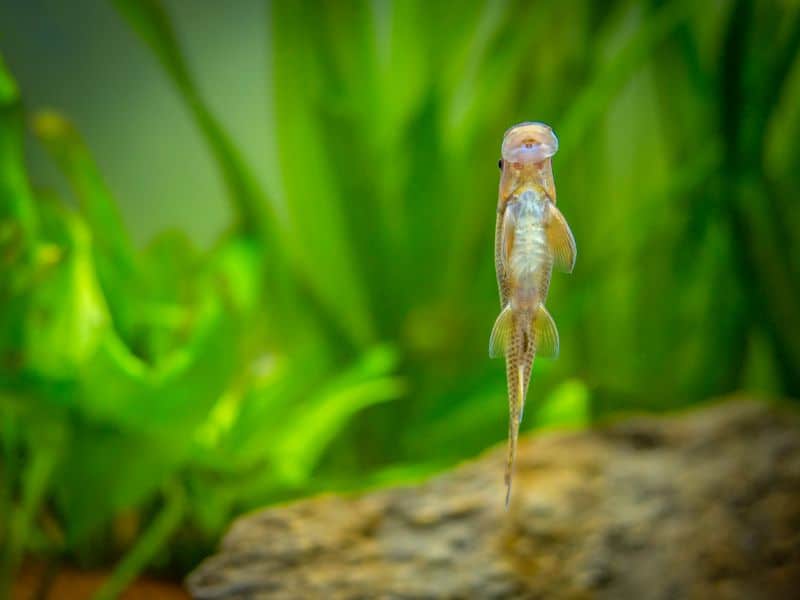Did you know that many Chinese Algae Eater owners do not feed them? This Southeast Asia species can live for years by just feeding on algae at the bottom of the tank.
They make for a prolific tank cleaning crew, but they can become harder to keep when they get older due to their aggression and dietary needs.
Despite these challenges, Chinese algae eaters are among the easiest freshwater fish to keep since they are low-maintenance and hardy enough to survive in various water conditions.
Read on to learn how to care for this freshwater fish properly; learn all the dos and don’ts regarding their environment, diet, and water parameters.
Chinese Algae Eater Species Overview
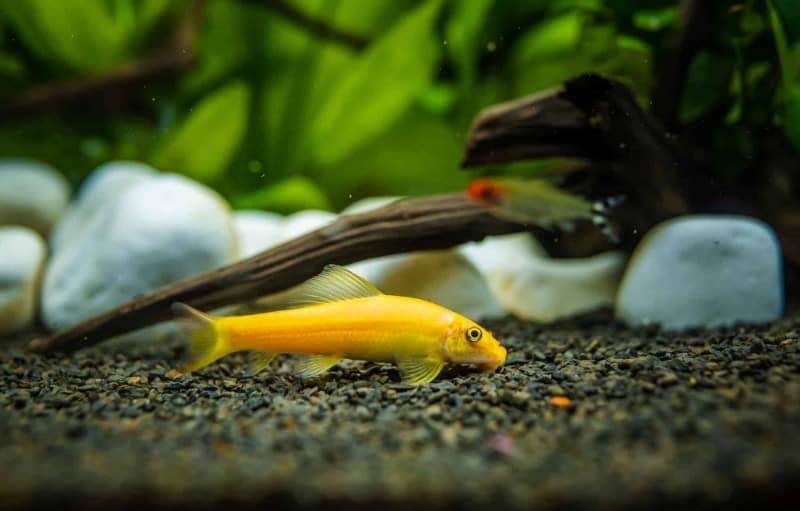
| Names | Chinese algae eater
Also known as a honey sucker, sucking loach, Chinese algae eater, Chinese sucker fish, golden Chinese algae eater, sucking catfish |
| Scientific Name | Gyrinocheilus aymonieri |
| Origins and Reginal Distribution | Originated from parts of Southeast Asia and native to the Chao Phraya basin and Vietnam rivers as well as Thailand |
| Tank Size | 30 gallons minimum for smaller 6-inch juvenile
50 gallons minimum for bigger 10+ inch adults |
| Water Hardness Conditions | 8 – 10 KH |
| Ideal Tank Mates | Less aggressive, equal-sized fish. |
| Average Size | 6 – 12 inches |
| Average Lifespan | Can live up to 10 years in an aquarium |
| Lighting Conditions | Medium to high light levels |
| Diet | Omnivorous |
| Optimal pH levels | 6.8 – 7.5 |
| Optimal Temperature | 75 – 85 degrees Fahrenheit |
Short Summary of Chinese Algae Eaters and their Habitats
Named after French linguist and explorer Etinenne Aymonier, the Chinese algae eater is a freshwater fish native to Asia and commonly known for its nutritional value in the local food market. It is also popular in the aquarium trade and easily found in many pet shops and fish farms.
Chinese algae eater is native to Southeast Asia’s deep, fast, and warmer waters in regions like the Chao Phraya Basin, Mae Klong Basin, Xe Bang Fai River, Mekong Basin, and rivers in Thailand, Vietnam, and Laos.
The Golden Chinese algae eater is a popular variant of the species that is native to parts like Northern India and Thailand, in medium to large lakes and flooded rivers.
Due to their environment, the fish have adopted a ‘sucker’ mouth feature that helps them attach themselves to smooth rocks and surfaces. This helps them remain stationary in the flooded rivers and fast-moving waters.
Chinese Algae Eater Lifespan
8 – 10 years is the average life expectancy of Chinese algae eaters.
The fish can live for longer or shorter periods depending on how well their habitat conditions are. A few examples have been noted to live for up to 11 years, but most cases include sucker fish with a lower life expectancy of less than 10 years.
Size: How Big Do Algae Eaters Get?
Chinese algae eaters can grow up to 12 inches in captivity. Most species range from 6 – 11 inches, but it is not uncommon to find one that is bigger.
Appearance: Colors, Features, Anatomy, Shape
Chinese algae eaters have a golden to brownish-yellow base color. The base color is complimented by black lateral stripes that run horizontally from the head to the tail of the fish. Depending on how old or the variant of the fish, these black lateral stripes can appear as spots, dots, or irregular patterns.
The species also has more than 30 lateral line scales that make up its entire exterior body and also features nine-branched dorsal fin rays that look like spikes – the only species with such patterns in its entire family genus.
They feature long, thin bodies with small fins and large ‘sucker’ mouths that can act as suction devices for holding onto surfaces. Often, the mouth is used to latch onto smoother surfaces at the bottom of their habitat.
Due to their suckermouth, the Chinese algae eaters cannot breathe through their mouths like other fish. Instead, they take in water through two-gill slits where water enters one and leaves through the other.
The sucker mouth is fun to watch and can be quite intriguing, but you may be surprised to know that it is considered an inferior evolutionary feature. Its only purpose is to help the fish latch itself to smooth surfaces in the wild, fast-flowing, and flood waters that make up their natural habitats.
Round yellow eyes compliment the base color giving it a monotone look which some find very appealing.
If you want a more vibrant color, then you may want to consider another variant of the species; only three variants of the fish are known to exist; the common Chinese algae eater, golden Chinese algae eater, and albino Chinese algae eater:
- Golden Chinese Algae eaters – Also known as the honey sucker, it is a honey-gold colored variant of Gyrinocheilos aymonieri with black lateral stripes and a paler belly. It came about due to selective breeding done over the years to improve its availability and coloration.
- Albino Chinese Algae Eater – It is a rare albino variant of Gyrinocheilos aymonieri with a paler pure golden coloration without any black lateral stripes.
Behavior
Chinese algae eaters are considered semi-aggressive since their aggression is usually targeted toward their own kind.
Otherwise, the suckerfish gets along with other species well unless they compete for territory or resources. Also, the Chinese algae eater’s temperament worsens when not properly fed.
With that in mind, it is advisable to only keep the fish in their own tanks without other mates.
The algae eaters are bottom feeders who scavenge for food at the lower sections of the water in their natural habitat, even in captivity. They make good tank cleaners and are rarely seen at the top of the water surface.
Chinese Algae Eater Care Guide
Caring for this species is easy since they are hardy creatures that live for long and can withstand a wide range of water conditions. A huge contributor to this fact is their algae-eating properties.
However, Chinese algae eaters are sensitive to nitrates and other toxic elements that may accumulate in the aquarium. Therefore, the first strategy to properly care for this fish is to invest in a good filtration system and perform regular water changes.
Tank Size
The recommended tank size is a minimum of 30 gallons for a smaller 6-inch juvenile. For bigger ones like the 11-inch adults, you will need at least 50 gallons to properly house them.
Chinese algae eaters also grow at a considerably fast rate which is why you should invest in a bigger tank for future-proofing.
Environment
Since they come from fast-flowing waters with warmer temperatures, it is best to invest in a good pump to create a powerful water flow.
Also, include a lid at the top to prevent the Chinese sucker fish from escaping since they are known to jump or swim their way out of the tank.
When it comes to the substrate, the fine sandy substrate at the bottom is the best. It helps prevent injury from rough and sharp edges that would be caused if you use gravel or rocky substrate.
If you put rocks in the tank, then use smooth flat ones with a large mix of sand. Rocks are very important to help algae accumulation and growth for the Chinese algae eaters to scavenge through and have their fill.
Lots of caves, driftwood, and décor go a long way toward simulating their natural environment. In addition to this, use standard medium to high light intensity equipment.
Do not forget to add plants and vegetation that are normally found in their wild habitats.
Tank Mates
Known to many experienced aquarists as natural loners, the honey sucker is best kept on its own without other tank mates.
As semi-aggressive fish, you need to ensure you do not overcrowd the tank to ensure they feel comfortable and non-threatened by other animals.
The honey sucker’s aggression increases as the fish gets older and becomes more territorial. Flat and smooth-bodied fish, as well as slow fish, are the main targets of their aggression. For this fact, it is considered a poor tank mate to many freshwater fish.
It is also best to avoid similar-colored fish, and it is not recommended to pair them up with their own kind since they often attack each other.
Also, avoid similar bottom feeders that primarily feed on algae and scavenge for food at the bottom. This includes avoiding algae-eaters like the shrimps, too, since they will get eaten or bullied by the bigger Chinese algae-eaters.
Opt for top dwellers and similar-sized or larger-sized fish that are non-aggressive and show no signs of territorial behavior.
The last fish you want to avoid pairing with honey suckers is smooth-surfaced fish since the Chinese algae eaters habitually latch onto their surfaces to eat slime coats off these fish’s bodies. Good examples are bala sharks, clown loach, and angelfish.
Some of the best Chinese algae eater tank mates include:
- Tetras like Emperor Tetra
- Gouramis like Dwarf Gourami
- Guppies
- Cherry barb
- Platies
- Zebrafish
- Molly Fish
- Betta fish
- Tiger Barbs
- Clown plecos
- Otocinclus catfish
Water Conditions
Filtration is key. Invest in a high-power filtration system to keep the nitrate and other toxic levels low. A good example is the power filter of the canister filter with biological filtration and current-varying power head to create fast or slow currents in the water.
Also, perform regular water changes. A 10 – 20 percent bi-weekly schedule is a good place to start. However, it is best to use your water test kit equipment to have a clear sense of how often the water should be changed.
You may need to perform the water changes more frequently or less often depending on your setup: tank mates, tank size, ecosystem, feeding habits, etc.
The ideal water parameters are as follows:
- pH level: 8 – 7.5
- Water hardness: 8 – 10 KH
- Water Temperature: 75 – 85 degrees Fahrenheit (can thrive in a wider range: 64 – 86)
- Water Movement: low to medium
Diet/Food
Become harder to keep when they get older because they stop eating as many algae as they would when they were younger. Their appetite changes with an increased need for more meat from live sources like bloodworms, brine, shrimp, and insect larvae.
These changes in appetite can be seen in how frequently they start to feed on body slime on other fish and how aggressive they get at attacking other fish and sometimes ripping off scales.
Refrain from overfeeding, as big 10-inch fish; they can produce a lot of waste which will be increased with lots of uneaten foods in the tank. Only feed them the amount that they can consume in a matter of minutes; otherwise, let them scavenge for food at the bottom till their next feeding.
Some of the best foods include:
- Algae wafers – especially for younger ones
- Frozen bloodworms
- Brine shrimp
- Tupifex
- Earthworms
- Freeze-dried foods.
- Standard pellets, flakes, and other frozen foods
- Crushed vegetables, including spinach, cucumber, broccoli, lettuce, and zucchini
- Shelled peas
- Chopped fruit
- Mosquito larvae
Breeding
Due to their aggression, it has been harder to breed Chinese algae eaters in captivity successfully. They often get too aggressive when sharing a tank with their own kind, and it takes a bigger space, careful trial and error, and meticulous planning, sometimes even luck, to make it happen.
Breeding is reliant on pair bonding. However, it is important to note that there are no noticeable physical differences between the female Chinese algae eater and their male counterparts, making it harder to pair them properly.
If you have managed to pair bond the male and the female successfully, then you can proceed to perform some standard practices used to breed other fish. These include:
- Ensure the pair has a safe and stress-free breeding tank.
- Increase the temperature above the regular parameters. In this case, above 80 degrees Fahrenheit. Do this for at least a week.
- Feed them more protein and vegetables depending on their preferred foods during this period.
- Once the eggs are laid, transfer them to a different layer tank to prevent the fish from eating the eggs, which often happens.
Chinese Algae Eater Price
You can find Chinese algae eaters for as much as $8 for adults and $1 for younger, smaller ones. Check with your local pet shops or online stores since prices can vary widely.
Also Read:
Frequently Asked Questions
Are Chinese Algae Eaters Good Algae Eaters?
Younger Chinese algae eaters are better at eating algae than older ones. Suppose you are looking for a great algae eater for tank cleaning.
In that case, you should choose a younger one, preferably less than 3 years old, or go for other popular tank cleaning species, including Otocinclus catfish, Siamese algae eater, common Pleco, Nerite snails, or Amano shrimp.
Do Chinese Algae Eaters Eat Snails?
Chinese algae eaters are not aggressive towards snails or smaller invest like shrimp. They do not eat snails as a source of food either. However, due to their sucker mouths, Chinese algae eaters tend to latch onto smooth surfaces, including snail shells. It is likely they will suck the snails out of their shells.
What Are the Differences Between Chinese Algae Eater vs. Siamese Algae Eater?
Chinese algae eaters (Gyrinocheilus almoner) are often easily mistaken for the Siamese algae eater (Crossocheilus siamensis) due to similar coloration and algae-eating habits. However, they vary in the following ways:
- Appearance: Chinese Algae Eaters have a slender, elongated body featuring a sucker mouth and prominent lips. Siamese algae eaters, on the other hand, have a more streamlined body shape with a horizontal black stripe that extends from their head to the tail.
- Size: Chinese Algae Eaters can grow up to 12 inches in length, making them relatively larger than Siamese Algae Eaters, which typically grow to about 4 inches.
- Temperament: Chinese Algae eaters are known to be more aggressive and territorial compared to Siamese. Algae Eaters, are generally peaceful and are more compatible with other fish.
- Algae-Eating Habits: Algae Eaters tend to become less efficient at consuming algae as they mature. Siamese Algae eaters usually continue to feed on algae throughout their lives.
Conclusion
The Chinese Algae Eater is a great choice for beginners who are looking to start a single-species, single-fish tank with little maintenance and food requirements.
You may also choose this species for its algae-eating properties, but there are better options that make much better choices as algae-eating fish, including the common pleco and Otocinclus catfish.
